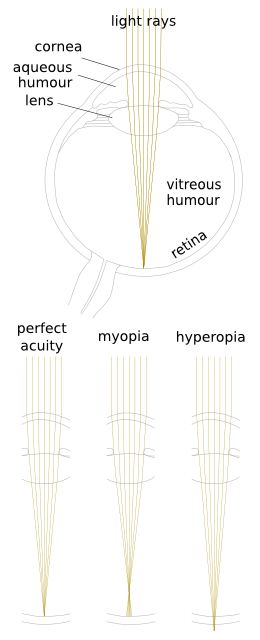Blurry vision and refractive power
/I'm getting LASIK eye surgery today, so I've been preparing myself by learning about the eye's optics, and the surgical procedure that enhances handicapped eyes like my own. Unsurprisingly, there are some noteworthy parallels with seismic.
 The eye as a gather
The eye as a gather
The human eye is akin to a common-depth point (CDP) gather. Both are like cameras constructed to focus rays at an imaging point. The retina, in the case of the eye; the reflection boundary in the case of the gather. In the eye, there are exactly four refracting interfaces at which light rays bend towards the midline and ultimately converge on the retina. In the earth, there an unknown number of interfaces, surely more than four.
Myopia, or near-sightedness, is the condition where images are focused just in front of the retina. Hyperopia, or far-sightedness, is the condition where the eyeball is too short and images would be focused behined the retina. The structure and density of the tissues in the eye have to be aligned just so, for perfect vision. If any combination of them are out of whack, you get blurry vision. Really blurry, in my case.
Characterizing blurry vision can be thought of as a two step process of measurement and validation. First, measurements of the refractive power of the eye are made with an autorefractor; quantifying the amount of first order correction needed. The correction is applied, verified, and fine-tuned by a qualitative visual assessment test. The measurement gets you close to the perfect correction; any residual adjustments may be negligible or imperceptible. And the patient, a subjective observer, is the final judge of clarity and quality of vision.
Four corrections
There are at least four ways to correct for common vision problems. Each is a different way to force the ray geometry:
- refract the light before it enters the eye (glasses),
- refract the light just above the cornea (contact lenses),
- change the shape of the cornea using LASIK or PRK surgery, or
- change the shape or structure of the lens (cataract surgery or implants).
If the earth were an eye
Seismic processing is the act of measuring the refractive structure of the earth, and correcting for it's natural blurryness. Static correction, is done first in an effort to align the rays into a plane wave before it enters the 'eye'. Seismic velocity analysis is carried out on the rays, as a crude measurement of the earth's 'refractive power'. Migration, is the process of forcing geometries, mathematically instead of surgically, in order to rearrange ray paths to improve focusing. Generally speaking it's the same two-step process: measurement and validation. As with the eye, the quality of the final image is a perceptual one, coming down to subjective visual assessment. But unlike the eye, fortunately, multiple observers can share the same image, talk about it even. Changing the entire discussion about what acuity really means.
The process of vision correction goes sequentially from low order to high order. In the next post I will talk about higher order anomalies within the eye, that, once corrected, can cause super-human vision. Measurements and maps of how the eye sees show surgeons how to correct optical images. In the same vein, measurements and maps of how the seismic experiment sees, show geophysicists how to correct images in the seismic realm.








 Except where noted, this content is licensed
Except where noted, this content is licensed